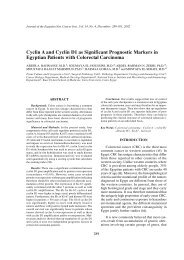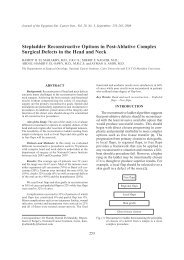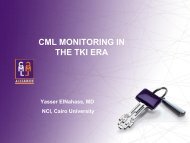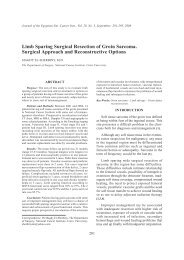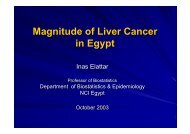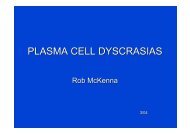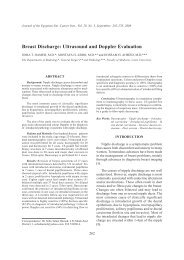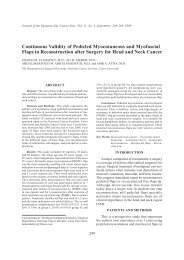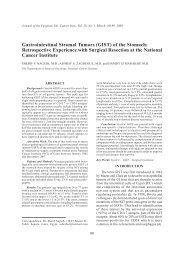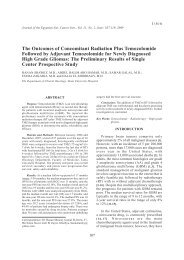Immediate Side Effects of Cranial Stereotactic Radiosurgery and ...
Immediate Side Effects of Cranial Stereotactic Radiosurgery and ...
Immediate Side Effects of Cranial Stereotactic Radiosurgery and ...
Create successful ePaper yourself
Turn your PDF publications into a flip-book with our unique Google optimized e-Paper software.
Mohamad Abdulla 331receive a radiation dose ranging from 0-8.1 Gywith a median value <strong>of</strong> 1.21 Gy to the regionlocated at the floor <strong>of</strong> the 4th ventricle <strong>and</strong>harboring area postrema, but the onset <strong>of</strong> vomitingwas correlated only with doses greater than2 Gy, contrasting to data reported by Alex<strong>and</strong>eret al. [1].The discrepancy with data reported by Alex<strong>and</strong>er<strong>and</strong> co-workers [1] could be attributed todifferent disease entities treated in our study,where he treated only cases with acuostic neuromas.However, further analysis <strong>of</strong> our datarevealed that 33% (7/21 patients) with acuosticneuromas had developed nausea <strong>and</strong> vomitingbut at a lower threshold dose level (2 versus6.18 Gy) to area postrema, a finding whichrequires further clarification via future studiesenrolling higher number <strong>of</strong> patients to establishthe threshold radiation dose to area postremaabove which, nausea <strong>and</strong> vomiting are anticipatedas immediate post-stereotxay morbid events.Also, inspite <strong>of</strong> the relatively close results withthose <strong>of</strong> Bodis et al. [4]; (2 versus 2.75 Gy) asa threshold dose level to area postrema, none <strong>of</strong>our patients had received ondansetron as a premedication;only metclopramide <strong>and</strong> steroidswhich were effecive in alleviating such manifestations.The incidence <strong>of</strong> developing immediate sideeffects among patients with malignant craniallesions was clearly higher than those with benigndiseases, 70% versus 43% indicating the needto pay more attention to proper patient selection<strong>and</strong> adequate pre- as well a post-treatment medicationsfor patients with high grade gliomas<strong>and</strong> brain metastases.Only two patients had developed epilepticepisodes following stereotaxy. They had thediagnoses <strong>of</strong> high grade glioma <strong>and</strong> brainmetastasis, also they had a past history <strong>of</strong> convulsivefits during their disease course <strong>and</strong> coulddirect attention to the importance <strong>of</strong> employingmore potent anti-convulsive measures whenattempting to treat similar patients.Worsening <strong>of</strong> pre-therapy manifestations wasreported in one, two <strong>and</strong> two patients with diagnoses<strong>of</strong> low grade glioma, high garde glioma<strong>and</strong> meningioma respectively. All lesions werenoted to be located near the motor cortex whichcould be compromised by either direct radiationeffect or more likely due to cerebral oedemam<strong>and</strong>ating the adequate use <strong>of</strong> dehydrating measuresin both pre- <strong>and</strong> post-therapy periods.Moreover, It is difficult to conclude that patientswith pituitary adenomas are not anticipated todevelop immediate post-stereotaxy side effects,as this conclusion cannot be emphasized withthe small number <strong>of</strong> patients enrolled in our trial(8 Patients).The location <strong>of</strong> lesions <strong>and</strong> dose are criticalparameters related to the development <strong>of</strong> poststereotacticradiosurgery <strong>and</strong> radiotherapy edema.It is well known that parasagittal meningiomasare a risk group in this respect. Occlusion <strong>of</strong>bridging veins is a possible though unprovenmechanism for this phenomenon. However, thisedema did not occur within the time frame <strong>of</strong>the present study.Further clinical trials are clearly neededincluding higher numbers <strong>of</strong> patients with homogenouscharacteristics aiming at obtainingmore informative data about stereotaxy sideeffects <strong>and</strong> its proper management. Also, it shouldbe emphasized to avoid radiation doses greaterthan 2 Gy to the region in the floor <strong>of</strong> the 4thventricle harboring area potrema with the possibleuse <strong>of</strong> H3 antagonists if higher dose deliveryis an inevitable event.Acknowledgment: I am grateful to Pr<strong>of</strong>. KamalA. El-Ghamrawi for critical review <strong>of</strong> Themainscript. Also, I would like to express mydeep appreciation to Pr<strong>of</strong>. Ehsan El-Ghoneimy& Pr<strong>of</strong>. Magda Moustafa as well as NEMROCKradiosurgery team for devotion <strong>and</strong> help.REFERENCES1- Alex<strong>and</strong>er E. 3rd, Siddon R <strong>and</strong> Loeffler J.: The AcuteOnset <strong>of</strong> Nausea <strong>and</strong> Vomiting Following <strong>Stereotactic</strong><strong>Radiosurgery</strong>: Correlation with Total Dose to AreaPostrema. Surg. Neurol., 32 (1): 40-44, 1989.2- Alex<strong>and</strong>er E. III, Loeffler J.S., Lunsford L.D., et al.:<strong>Stereotactic</strong> <strong>Radiosurgery</strong>. New York: McGraw Hill,1993.3- Altman D.G.: Practical statistics for medical research.London, Chapman & Hall, 115-231, 1991.4- Bodis S., Alex<strong>and</strong>er E. III, Kooy H., et al.: The Prevention<strong>of</strong> <strong>Radiosurgery</strong>-Induced Nausea <strong>and</strong> Vomitingby Ondansetron: Evidence <strong>of</strong> a Direct Effect on TheCentral Nervous System Chemoreceptor Trigger Zone.Surg. Neurol., 42: 249-252, 1994.5- Brenner D.J., Martel M.K. <strong>and</strong> Hall E.J.: FractionatedRegimens For <strong>Stereotactic</strong> Radiotherapy <strong>of</strong> RecurrentTumors in The Brain. Int. J. Radiat. Oncol. Biol. Phys.,21: 819-824, 1991.



